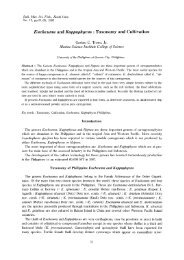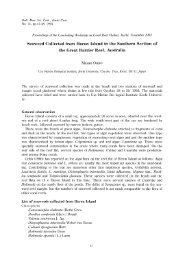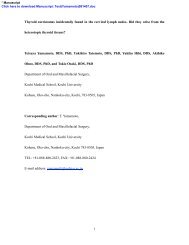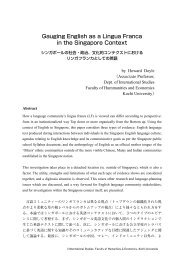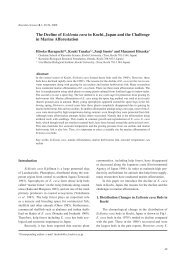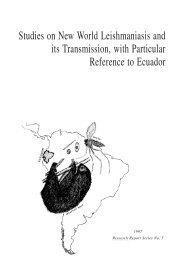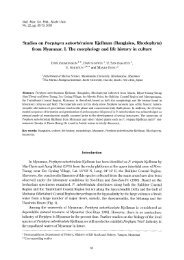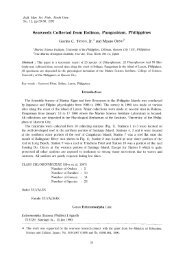effector phase induced allergic conjunctivitis in mice during the ...
effector phase induced allergic conjunctivitis in mice during the ...
effector phase induced allergic conjunctivitis in mice during the ...
Create successful ePaper yourself
Turn your PDF publications into a flip-book with our unique Google optimized e-Paper software.
Downloaded from bjo.bmj.com on February 16, 2010 - Published by group.bmj.com<br />
Interleuk<strong>in</strong> 10 and transform<strong>in</strong>g growth factor β<br />
contribute to <strong>the</strong> development of experimentally<br />
<strong><strong>in</strong>duced</strong> <strong>allergic</strong> <strong>conjunctivitis</strong> <strong>in</strong> <strong>mice</strong> dur<strong>in</strong>g <strong>the</strong><br />
<strong>effector</strong> <strong>phase</strong><br />
A Fukushima, T Sumi, K Fukuda, et al.<br />
Br J Ophthalmol 2006 90: 1535-1541 orig<strong>in</strong>ally published onl<strong>in</strong>e August 16, 2006<br />
doi: 10.1136/bjo.2006.100180<br />
Updated <strong>in</strong>formation and services can be found at:<br />
http://bjo.bmj.com/content/90/12/1535.full.html<br />
References<br />
Email alert<strong>in</strong>g<br />
service<br />
These <strong>in</strong>clude:<br />
This article cites 25 articles, 11 of which can be accessed free at:<br />
http://bjo.bmj.com/content/90/12/1535.full.html#ref-list-1<br />
Article cited <strong>in</strong>:<br />
http://bjo.bmj.com/content/90/12/1535.full.html#related-urls<br />
Receive free email alerts when new articles cite this article. Sign up <strong>in</strong> <strong>the</strong> box at<br />
<strong>the</strong> top right corner of <strong>the</strong> onl<strong>in</strong>e article.<br />
Topic collections<br />
Articles on similar topics can be found <strong>in</strong> <strong>the</strong> follow<strong>in</strong>g collections<br />
Ocular Conjunctiva (151 articles)<br />
surface (379 articles)<br />
Notes<br />
To order repr<strong>in</strong>ts of this article go to:<br />
http://bjo.bmj.com/cgi/repr<strong>in</strong>tform<br />
To subscribe to British Journal of Ophthalmology go to:<br />
http://bjo.bmj.com/subscriptions
Downloaded from bjo.bmj.com on February 16, 2010 - Published by group.bmj.com<br />
1535<br />
EXTENDED REPORT<br />
Interleuk<strong>in</strong> 10 and transform<strong>in</strong>g growth factor b<br />
contribute to <strong>the</strong> development of experimentally<br />
<strong><strong>in</strong>duced</strong> <strong>allergic</strong> <strong>conjunctivitis</strong> <strong>in</strong> <strong>mice</strong> dur<strong>in</strong>g <strong>the</strong><br />
<strong>effector</strong> <strong>phase</strong><br />
A Fukushima, T Sumi, K Fukuda, N Kumagai, T Nishida, H Yagita, H Ueno<br />
...............................................................................................................................<br />
Br J Ophthalmol 2006;90:1535–1541. doi: 10.1136/bjo.2006.100180<br />
See end of article for<br />
authors’ affiliations<br />
.......................<br />
Correspondence to:<br />
A Fukushima, Department<br />
of Ophthalmology, Kochi<br />
Medical School, Kohasu,<br />
Oko-cho, Nankoku-city<br />
783-8505, Japan;<br />
fukusima@med.kochi-u.<br />
ac.jp<br />
Accepted 1 August 2006<br />
Published Onl<strong>in</strong>e First<br />
16 August 2006<br />
.......................<br />
Aim: To <strong>in</strong>vestigate <strong>the</strong> <strong>in</strong>volvement of <strong>in</strong>terleuk<strong>in</strong> (IL)10 and transform<strong>in</strong>g growth factor (TGF) b <strong>in</strong> <strong>the</strong><br />
development of experimentally <strong><strong>in</strong>duced</strong> <strong>allergic</strong> <strong>conjunctivitis</strong> <strong>in</strong> <strong>mice</strong>.<br />
Methods: Balb/c <strong>mice</strong> were actively sensitised with ragweed <strong>in</strong> alum, and <strong>the</strong>n challenged with ragweed<br />
<strong>in</strong> eye drops after 10 days. 24 h later, <strong>the</strong> conjunctivas, spleens and blood were collected for histological<br />
and cytok<strong>in</strong>e expression analyses, proliferation and cytok<strong>in</strong>e production assays and measurement of<br />
immunoglobul<strong>in</strong> (Ig) levels. Mice develop<strong>in</strong>g experimentally <strong><strong>in</strong>duced</strong> <strong>allergic</strong> <strong>conjunctivitis</strong> were <strong>in</strong>jected<br />
<strong>in</strong>traperitoneally with 200 mg of anti-IL10 or anti-TGF b antibodies at 0, 2, 4, 6 and 8 days (<strong>in</strong>duction<br />
<strong>phase</strong> treatment) or 500 mg of antibodies 2 h before ragweed challenge (<strong>effector</strong> <strong>phase</strong> treatment).<br />
Normal rat IgG was used for control <strong>in</strong>jections.<br />
Results: Treatment with ei<strong>the</strong>r anti-IL10 or anti-TGF b antibodies dur<strong>in</strong>g <strong>the</strong> <strong>in</strong>duction <strong>phase</strong> did not affect<br />
eos<strong>in</strong>ophil <strong>in</strong>filtration <strong>in</strong>to <strong>the</strong> conjunctiva. By contrast, treatment with ei<strong>the</strong>r antibody dur<strong>in</strong>g <strong>the</strong> <strong>effector</strong><br />
<strong>phase</strong> suppressed <strong>in</strong>filtration. Dur<strong>in</strong>g <strong>the</strong> <strong>effector</strong> <strong>phase</strong>, treatment with anti-TGF b antibody, but not <strong>the</strong><br />
anti-IL10 antibody, markedly up regulated proliferation and Th2 cytok<strong>in</strong>e production by splenocytes. IL1a<br />
levels <strong>in</strong> <strong>the</strong> conjunctiva were reduced after treatment with ei<strong>the</strong>r antibody; <strong>in</strong> addition, eotax<strong>in</strong> and tumour<br />
necrosis factor a levels were reduced after treatment with antibody to TGF b.<br />
Conclusions: IL10 and TGF b do not have immunosuppressive roles <strong>in</strong> <strong>the</strong> development of experimentally<br />
<strong><strong>in</strong>duced</strong> <strong>allergic</strong> <strong>conjunctivitis</strong>. Ra<strong>the</strong>r, <strong>the</strong>y augment <strong>the</strong> <strong>in</strong>filtration of eos<strong>in</strong>ophils <strong>in</strong>to <strong>the</strong> conjunctiva<br />
dur<strong>in</strong>g <strong>the</strong> <strong>effector</strong> <strong>phase</strong> of experimentally <strong><strong>in</strong>duced</strong> <strong>allergic</strong> <strong>conjunctivitis</strong>.<br />
Severe forms of <strong>allergic</strong> <strong>conjunctivitis</strong> such as vernal<br />
kerato<strong>conjunctivitis</strong> are characterised by <strong>the</strong> formation<br />
of giant papillae <strong>in</strong> <strong>the</strong> palpebral conjunctiva. 1 These<br />
papillae are formed by proliferation of fibroblasts and<br />
massive <strong>in</strong>filtration of <strong>in</strong>flammatory cells, <strong>in</strong>clud<strong>in</strong>g eos<strong>in</strong>ophils.<br />
2 In addition to contribut<strong>in</strong>g to <strong>the</strong> formation of giant<br />
papillae, <strong>in</strong>filtrat<strong>in</strong>g eos<strong>in</strong>ophils may lead to vision loss. In<br />
patients with atopic kerato<strong>conjunctivitis</strong>, eos<strong>in</strong>ophil numbers<br />
<strong>in</strong> tear fluids <strong>in</strong>crease with <strong>the</strong> severity of corneal damage, 3<br />
<strong>in</strong>dicat<strong>in</strong>g that eos<strong>in</strong>ophils have an important role <strong>in</strong> <strong>the</strong><br />
severity of <strong>allergic</strong> <strong>conjunctivitis</strong>. Therefore, it could be<br />
considered that quantification of conjunctival <strong>in</strong>filtrat<strong>in</strong>g<br />
eos<strong>in</strong>ophils is suitable to evaluate <strong>the</strong> severity of <strong>allergic</strong><br />
<strong>conjunctivitis</strong>. We have <strong>in</strong>vestigated <strong>the</strong> mechanism by which<br />
eos<strong>in</strong>ophils <strong>in</strong>filtrate <strong>in</strong>to <strong>the</strong> conjunctiva dur<strong>in</strong>g development<br />
of <strong>allergic</strong> <strong>conjunctivitis</strong>, us<strong>in</strong>g experimental <strong>allergic</strong><br />
<strong>conjunctivitis</strong> (experimental immune-mediated blepharo<strong>conjunctivitis</strong>)<br />
<strong>in</strong> rats 4–6 and <strong>mice</strong>. 7–10 Accumulat<strong>in</strong>g evidence has<br />
confirmed that antigen-specific T cells (Th2 cells <strong>in</strong> particular)<br />
have a crucial role <strong>in</strong> <strong>the</strong> <strong>in</strong>filtration of eos<strong>in</strong>ophils <strong>in</strong>to<br />
<strong>the</strong> conjunctiva dur<strong>in</strong>g experimental immune-mediated<br />
blepharo<strong>conjunctivitis</strong> development. 11<br />
T cell immune responses are suppressed by immunoregulatory<br />
cytok<strong>in</strong>es, of which <strong>in</strong>terleuk<strong>in</strong> (IL)10 and transform<strong>in</strong>g<br />
growth factor (TGF) b are considered to be representative<br />
12 13<br />
cytok<strong>in</strong>es, as <strong>the</strong>y are produced by regulatory T cells.<br />
There have been several <strong>in</strong>vestigations <strong>in</strong>to <strong>the</strong> <strong>in</strong>volvement<br />
of IL10 and TGF b <strong>in</strong> experimentally-<strong><strong>in</strong>duced</strong> <strong>allergic</strong> disease.<br />
For example, adm<strong>in</strong>istration of exogenous IL10 before<br />
allergen treatment has been shown to <strong>in</strong>duce antigen-specific<br />
T cell tolerance <strong>in</strong> an experimental dermatitis model. 14 In<br />
addition, endogenous IL10 was found to suppress allergen<strong><strong>in</strong>duced</strong><br />
airway <strong>in</strong>flammation; similarly, CD4+ T cells<br />
15 16<br />
eng<strong>in</strong>eered to produce IL10 were shown to prevent allergen<strong><strong>in</strong>duced</strong><br />
airway <strong>in</strong>flammation, 17 suggest<strong>in</strong>g that IL10 has an<br />
immunosuppressive role dur<strong>in</strong>g <strong>allergic</strong> <strong>in</strong>flammation. By<br />
contrast, it was reported that IL10 promotes airway hyperresponsiveness<br />
18 and even eos<strong>in</strong>ophilia 19 <strong>in</strong> allergen-<strong><strong>in</strong>duced</strong><br />
airway <strong>in</strong>flammation. With regard to TGF b, block<strong>in</strong>g of<br />
CTLA-4 enhances <strong>allergic</strong> <strong>in</strong>flammation but decreases TGF b<br />
levels <strong>in</strong> bronchoalveolar lavage fluid. 20 Fur<strong>the</strong>rmore, TGF b<br />
secreted from CD4+ T cells was found to ameliorate antigen<strong><strong>in</strong>duced</strong><br />
tracheal eos<strong>in</strong>ophilia. 21 Thus, TGF b seems to act as a<br />
suppressive cytok<strong>in</strong>e dur<strong>in</strong>g <strong>the</strong> development of <strong>allergic</strong><br />
airway <strong>in</strong>flammation, whereas it rema<strong>in</strong>s unclear whe<strong>the</strong>r<br />
IL10 always exhibits this function. However, so far, <strong>the</strong> roles<br />
of <strong>the</strong>se two cytok<strong>in</strong>es <strong>in</strong> <strong>allergic</strong> <strong>conjunctivitis</strong> have not been<br />
<strong>in</strong>vestigated.<br />
In this report, to <strong>in</strong>vestigate <strong>the</strong> roles of IL10 and TGF b <strong>in</strong><br />
<strong>the</strong> development of <strong>allergic</strong> <strong>conjunctivitis</strong>, we treated<br />
experimentally <strong><strong>in</strong>duced</strong> <strong>allergic</strong> <strong>conjunctivitis</strong>-develop<strong>in</strong>g<br />
<strong>mice</strong> with neutralis<strong>in</strong>g antibodies to both cytok<strong>in</strong>es.<br />
MATERIALS AND METHODS<br />
Mice<br />
Inbred Balb/c <strong>mice</strong> were purchased from Japan SLC<br />
(Hamamatsu, Shizuoka, Japan). The <strong>mice</strong> were kept <strong>in</strong><br />
pathogen-free conditions at <strong>the</strong> Animal Facility of Kochi<br />
Abbreviations: nrIgG, normal rat immunoglobul<strong>in</strong> G; PBS, phosphatebuffered<br />
sal<strong>in</strong>e; TNF, tumour necrosis factor; TGF, transform<strong>in</strong>g growth<br />
factor<br />
www.bjophthalmol.com
Downloaded from bjo.bmj.com on February 16, 2010 - Published by group.bmj.com<br />
1536 Fukushima, Sumi, Fukuda, et al<br />
Figure 1 Effects of antibody treatment dur<strong>in</strong>g <strong>the</strong> <strong>in</strong>duction <strong>phase</strong> on systemic immune responses. Spleens and blood were collected to evaluate<br />
ragweed (RW)-<strong><strong>in</strong>duced</strong> proliferation (A) and cytok<strong>in</strong>e production (B) of splenocytes and total Ig levels <strong>in</strong> serum (C), respectively. (A) Data are expressed<br />
as D cpm. Background cpm ¡ SEM were: 1163 ¡ 22 <strong>in</strong> normal rat immunoglobul<strong>in</strong> G (nrIgG)-treated (control) group; 985 ¡ 49 <strong>in</strong> <strong>the</strong> anti-IL10<br />
antibody-treated group; and 1102 ¡ 22 <strong>in</strong> <strong>the</strong> anti-TGF b antibody-treated group. (B) Data are expressed as pg/ml. (C) Data are expressed as ng/ml<br />
or mg/ml. *p,0.01, **p,0.05, compared with nrIgG-treated group.<br />
Medical School, Nankoku, Japan, and age-matched and sexmatched<br />
<strong>mice</strong> were used at 6–12 weeks of age. All research<br />
conformed to <strong>the</strong> Association for Research <strong>in</strong> Vision and<br />
Ophthalmology Statement for <strong>the</strong> Use of Animals <strong>in</strong><br />
Ophthalmic and Vision Research.<br />
Reagents<br />
Short ragweed pollen was purchased from Polysciences,<br />
Warr<strong>in</strong>gton, Pennsylvania, USA. Ragweed extract was<br />
obta<strong>in</strong>ed from LSL , Tokyo, Japan. Alum<strong>in</strong>ium hydroxide<br />
(alum) was purchased from Sigma, St Louis, Missouri, USA.<br />
www.bjophthalmol.com
Downloaded from bjo.bmj.com on February 16, 2010 - Published by group.bmj.com<br />
Experimental <strong>allergic</strong> <strong>conjunctivitis</strong> 1537<br />
Hybridomas produc<strong>in</strong>g neutralis<strong>in</strong>g antibodies to IL10 (JES5-<br />
2A5) 22 and TGF b (1D11) 23 were obta<strong>in</strong>ed from <strong>the</strong> ATCC.<br />
These antibodies for <strong>in</strong> vivo treatments were purified from<br />
ascites us<strong>in</strong>g a prote<strong>in</strong> G column and conta<strong>in</strong>ed ,100 pg/ml<br />
endotox<strong>in</strong>. For <strong>the</strong> control treatment, normal rat immunoglobul<strong>in</strong><br />
G (nrIgG) was purchased from MP Biomedicals,<br />
Aurora, Ohio, USA.<br />
Experimentally <strong><strong>in</strong>duced</strong> <strong>allergic</strong> <strong>conjunctivitis</strong> and<br />
treatment with antibodies dur<strong>in</strong>g <strong>the</strong> <strong>in</strong>duction <strong>phase</strong><br />
Fifty ml of <strong>the</strong> emulsion conta<strong>in</strong><strong>in</strong>g ragweed (50 mg) adsorbed<br />
to alum (675 mg) was <strong>in</strong>jected <strong>in</strong>to both <strong>the</strong> left h<strong>in</strong>d-footpad<br />
and <strong>the</strong> tail base of each mouse. The <strong>mice</strong> were <strong>in</strong>jected<br />
<strong>in</strong>traperitoneally with 200 mg of purified anti-IL10 (n = 10)<br />
or anti-TGF b (n = 10) antibodies, or nrIgG (n = 10) at 0, 2, 4,<br />
6 and 8 days after immunisation. Ten days later, <strong>the</strong> eyes of<br />
<strong>the</strong> immunised <strong>mice</strong> were challenged with ragweed <strong>in</strong><br />
phosphate-buffered sal<strong>in</strong>e (PBS; 2 mg <strong>in</strong> 10 ml per eye);<br />
24 h later, <strong>the</strong> eyes, sera and spleens were harvested for<br />
histological and cytok<strong>in</strong>e expression analyses, measurement<br />
of Ig levels, and cytok<strong>in</strong>e production or proliferation assays,<br />
respectively.<br />
Experimentally <strong><strong>in</strong>duced</strong> <strong>allergic</strong> conjunctivities and<br />
treatment with antibodies dur<strong>in</strong>g <strong>the</strong> <strong>effector</strong> <strong>phase</strong><br />
Ragweed adsorbed on alum was <strong>in</strong>jected <strong>in</strong>to <strong>the</strong> left h<strong>in</strong>dfootpad<br />
and <strong>the</strong> tail base of each mouse as described above.<br />
Ten days later, <strong>the</strong> eyes of <strong>the</strong> immunised <strong>mice</strong> were<br />
challenged with ragweed <strong>in</strong> PBS (2 mg <strong>in</strong> 10 ml per eye).<br />
Two hours before <strong>the</strong> ragweed challenge, <strong>the</strong> <strong>mice</strong> were<br />
<strong>in</strong>jected <strong>in</strong>traperitoneally with 500 mg of purified anti-IL10<br />
(n = 13) or anti-TGF b (n = 13) antibodies or nrIgG (n = 13).<br />
Twenty four hours later, <strong>the</strong> eyes, sera and spleens were<br />
harvested for histological analysis, measurement of Ig levels,<br />
and T cell culture for transfer, cytok<strong>in</strong>e production and<br />
proliferation assays, respectively.<br />
Experimentally <strong><strong>in</strong>duced</strong> <strong>allergic</strong> <strong>conjunctivitis</strong> by<br />
adoptive transfer of splenocytes from actively<br />
immunised <strong>mice</strong> that had been treated with antibodies<br />
dur<strong>in</strong>g <strong>the</strong> <strong>effector</strong> <strong>phase</strong><br />
Splenocytes harvested from <strong>the</strong> <strong>mice</strong> described above were<br />
cultured with ragweed extract at f<strong>in</strong>al concentrations of 5 mg/<br />
ml <strong>in</strong> 75 cm 2 flasks at 10 7 cells/ml <strong>in</strong> 20 ml RPMI 1640<br />
medium supplemented with 10% fetal calf serum ( ICN<br />
Biomedical Japan, Tokyo, Japan), 5610 25 M 2-mercaptoethanol,<br />
2 mM L-glutam<strong>in</strong>e, 100 U/ml penicill<strong>in</strong> and<br />
100 mg/ml streptomyc<strong>in</strong>. After <strong>in</strong>cubation for 72 h at 37˚C<br />
<strong>in</strong> a humidified atmosphere conta<strong>in</strong><strong>in</strong>g 5% CO 2 , 2610 7<br />
splenocytes were <strong>in</strong>jected <strong>in</strong>traperitoneally <strong>in</strong>to naive Balb/c<br />
<strong>mice</strong> (n = 8 <strong>mice</strong> per group). Four days after <strong>the</strong> transfer, <strong>the</strong><br />
eyes of <strong>the</strong> recipient <strong>mice</strong> were challenged with ragweed <strong>in</strong><br />
PBS (2 mg <strong>in</strong> 10 ml per eye), and 24 h later, <strong>the</strong> eyes and<br />
spleens were harvested for histological analysis.<br />
Histological analysis<br />
Eyes (<strong>in</strong>clud<strong>in</strong>g conjunctivas) were harvested and fixed <strong>in</strong><br />
10% buffered formal<strong>in</strong>, cut <strong>in</strong>to horizontal 2-mm-thick<br />
sections and sta<strong>in</strong>ed with Giemsa. In each section, <strong>in</strong>filtrat<strong>in</strong>g<br />
eos<strong>in</strong>ophils <strong>in</strong> <strong>the</strong> lam<strong>in</strong>a propria mucosae of <strong>the</strong> tarsal<br />
and bulbar conjunctivas were counted by two observers who<br />
were not apprised of <strong>the</strong> experimental treatment given to <strong>the</strong><br />
samples. The sections counted were those of <strong>the</strong> central<br />
portion of <strong>the</strong> eye, which <strong>in</strong>cluded <strong>the</strong> pupil and optic nerve<br />
head. The data are presented as <strong>the</strong> mean ¡ SEM per slide.<br />
Cellular proliferation assay<br />
Red blood cell-depleted splenocytes (3610 5 cells/well) were<br />
cultured <strong>in</strong> 96-well flat-bottom plates <strong>in</strong> 0.2 ml of RPMI 1640<br />
medium supplemented with 5% fetal calf serum and 2-<br />
mercaptoethanol. The cells were stimulated with ragweed<br />
at f<strong>in</strong>al concentrations of 0.2, 1, 5 and 25 mg/ml. After a 72-h<br />
<strong>in</strong>cubation at 37˚C <strong>in</strong> a humidified atmosphere conta<strong>in</strong><strong>in</strong>g<br />
5% CO 2 , <strong>the</strong> cultures were pulsed for 16 h with 0.5 mCi/well<br />
[ 3 H]thymid<strong>in</strong>e (Japan Atomic Energy Research Institute,<br />
Tokai, Japan). The cultures were <strong>the</strong>n harvested and <strong>the</strong><br />
<strong>in</strong>corporated radioactivity was measured by standard<br />
techniques. The data were expressed as change <strong>in</strong> counts<br />
per m<strong>in</strong>ute (cpm; mean cpm of stimulated cultures m<strong>in</strong>us<br />
mean cpm of unstimulated control cultures). One representative<br />
data of four <strong>in</strong>dividual experiments is shown as<br />
Figures.<br />
Measurement of total Ig levels <strong>in</strong> serum<br />
Twenty four hours after ragweed challenge of immunised<br />
<strong>mice</strong>, blood was collected and serum prepared. Serum Ig<br />
levels were assessed us<strong>in</strong>g ELISA; <strong>in</strong> brief, EIA plates (Costar,<br />
Corn<strong>in</strong>g, New York, USA) were coated with goat anti-mouse<br />
IgG antibody (2 mg/ml; Sigma) or aff<strong>in</strong>ity-purified antimouse<br />
IgE antibody (2 mg/ml; eBioscience, San Diego,<br />
California, USA). After block<strong>in</strong>g with 1% bov<strong>in</strong>e serum<br />
album<strong>in</strong> <strong>in</strong> PBS, serum samples (diluted from 1/100 to 1/<br />
10000 <strong>in</strong> PBS) were added <strong>in</strong> duplicate and <strong>in</strong>cubated for 2 h<br />
at room temperature or overnight at 4˚C. The plates were<br />
<strong>the</strong>n washed with PBS plus 0.05% Tween 20 (PBS/T; Wako,<br />
Osaka, Japan) and <strong>in</strong>cubated for 2 h at room temperature<br />
with alkal<strong>in</strong>e phosphatase-conjugated goat antibodies specific<br />
for IgG 1 or IgG 2a (Zymed, San Francisco, California,<br />
USA). In <strong>the</strong> case of IgE, biot<strong>in</strong>-conjugated rat anti-mouse<br />
IgE antibody (BD Biosciences, Frankl<strong>in</strong> Lakes, New Jersey,<br />
USA) was added to each well for 2 h at room temperature.<br />
After wash<strong>in</strong>g, avid<strong>in</strong>-alkal<strong>in</strong>e phosphatase (Sigma) was<br />
added to each well for 1 h. After wash<strong>in</strong>g with PBS/T, p-<br />
nitrophenyl phosphate (p-nitrophenyl phosphate liquid substrate<br />
system, Sigma) was added to each well and allowed to<br />
develop for 15 m<strong>in</strong>, after which absorbance was measured at<br />
405 nm. Ig concentrations were calculated us<strong>in</strong>g <strong>the</strong> l<strong>in</strong>ear<br />
ranges of <strong>the</strong> dilution and standard curves generated with<br />
purified mouse IgG 1 (BioLegend, San Diego, California,<br />
USA), mouse IgG 2a (eBioscience) and mouse IgE (BD<br />
Biosciences).<br />
Measurement of cytok<strong>in</strong>es <strong>in</strong> <strong>the</strong> culture supernatants<br />
Red blood cell-depleted splenocytes (10 7 cells/ml) were<br />
cultured for 48 h with ragweed (25 mg/ml) <strong>in</strong> 96-well flatbottom<br />
plates <strong>in</strong> 0.2 ml RPMI 1640 medium supplemented<br />
with 10% fetal calf serum and 2-mercaptoethanol. Levels of<br />
IL2, IL4, IL5 and IL10 were measured us<strong>in</strong>g <strong>the</strong> Bioplex<br />
system (Bio-Rad, Hercules, California, USA) accord<strong>in</strong>g to <strong>the</strong><br />
manufacturer’s <strong>in</strong>structions. Data are shown as <strong>the</strong> average<br />
¡ SEM (pg/ml) of four <strong>in</strong>dividual experiments.<br />
Measurement of cytok<strong>in</strong>es <strong>in</strong> <strong>the</strong> conjunctiva<br />
Multiple cytok<strong>in</strong>e levels <strong>in</strong> <strong>the</strong> conjunctiva (17 cytok<strong>in</strong>es:<br />
IL1a, IL1b, IL2, IL3, IL4, IL5, IL6, IL9, IL10, IL12 (p40),<br />
IL12 (p70), IL13, IL17, G-CSF, GM-CSF, <strong>in</strong>terferon c and<br />
tumour necrosis factor (TNF) a; and 6 chemok<strong>in</strong>es: eotax<strong>in</strong>,<br />
KC, MCP 1, MIP 1a, MIP 1b and RANTES) were measured<br />
us<strong>in</strong>g <strong>the</strong> Bioplex system. The excised conjunctivas from<br />
experimentally <strong><strong>in</strong>duced</strong> <strong>allergic</strong> <strong>conjunctivitis</strong>-develop<strong>in</strong>g<br />
<strong>mice</strong> treated with nrIgG, anti-IL10 antibody, or anti-TGF b<br />
antibody (n = 5 per group) were weighed, cut <strong>in</strong>to small<br />
pieces and <strong>the</strong>n homogenised <strong>in</strong> 100 ml of lysis buffer.<br />
The samples were <strong>the</strong>n centrifuged at 6000 rpm for 5 m<strong>in</strong>,<br />
and 50 ml of each supernatant subjected to analysis. Data<br />
are expressed as <strong>the</strong> mean ¡ SEM of pg cytok<strong>in</strong>e/mg<br />
conjunctiva.<br />
www.bjophthalmol.com
Downloaded from bjo.bmj.com on February 16, 2010 - Published by group.bmj.com<br />
1538 Fukushima, Sumi, Fukuda, et al<br />
Statistical analysis<br />
Differences between <strong>the</strong> anti-IL10-treated or anti-TGFbtreated<br />
and nrIgG-treated <strong>mice</strong> and between anti-IL10-<br />
treated and anti-TGF b-treated <strong>mice</strong> <strong>in</strong> terms of <strong>the</strong>ir serum<br />
IgE levels, splenocyte proliferation, cytok<strong>in</strong>e production and<br />
<strong>in</strong>filtrat<strong>in</strong>g eos<strong>in</strong>ophil numbers were tested for significance<br />
by Mann–Whitney U test. p Values ,0.05 were considered to<br />
be significant.<br />
RESULTS<br />
Neutralisation of IL10 or TGF b dur<strong>in</strong>g <strong>the</strong> <strong>in</strong>duction<br />
<strong>phase</strong> does not affect experimentally <strong><strong>in</strong>duced</strong> <strong>allergic</strong><br />
<strong>conjunctivitis</strong><br />
To determ<strong>in</strong>e whe<strong>the</strong>r or not IL10 and TGF b are <strong>in</strong>volved <strong>in</strong><br />
<strong>the</strong> development of experimentally <strong><strong>in</strong>duced</strong> <strong>allergic</strong> <strong>conjunctivitis</strong><br />
dur<strong>in</strong>g <strong>the</strong> <strong>in</strong>duction <strong>phase</strong>, Balb/c <strong>mice</strong> were actively<br />
immunised with ragweed and treated with anti-IL10 or anti-<br />
TGF b antibodies (200 mg per time) five times (1 mg total)<br />
every o<strong>the</strong>r day from <strong>the</strong> day of immunisation. These <strong>mice</strong><br />
were <strong>the</strong>n challenged with ragweed-conta<strong>in</strong><strong>in</strong>g eye drops on<br />
day 10. Twenty four hours after <strong>the</strong> challenge, <strong>the</strong> conjunctivas<br />
were harvested to evaluate eos<strong>in</strong>ophil <strong>in</strong>filtration.<br />
Eos<strong>in</strong>ophil <strong>in</strong>filtration <strong>in</strong> nrIgG-treated group was not<br />
different from that <strong>in</strong> <strong>mice</strong> treated without any antibodies<br />
(data not shown). Compared with <strong>the</strong> control group that had<br />
been treated with nrIgG (average number of conjunctival<br />
eos<strong>in</strong>ophils ¡ SEM = 42.0 ¡ 6.7), <strong>in</strong>filtration of eos<strong>in</strong>ophils<br />
<strong>in</strong>to <strong>the</strong> conjunctiva was not significantly different for ei<strong>the</strong>r<br />
<strong>the</strong> anti-IL10 antibody-treated (42.4 ¡ 8.2) or anti-TGF b<br />
antibody-treated groups (39.9 ¡ 7.2). There were no<br />
significant differences <strong>in</strong> proliferation (fig 1A) or cytok<strong>in</strong>e<br />
production (fig 1B) of ragweed-stimulated splenocytes<br />
between anti-IL10 or anti-TGF b antibody treatments and<br />
controls (nrIgG). However, anti-IL10 antibody treatment<br />
significantly decreased total IgE, IgG 1 and IgG 2a levels,<br />
whereas treatment with anti-TGF b antibody significantly<br />
decreased total IgG 2a levels (fig 1C). Thus, neutralisation of<br />
IL10 and TGF b affected systemic humoral immune responses<br />
but had no effect on eos<strong>in</strong>ophil <strong>in</strong>filtration.<br />
Neutralisation of IL10 or TGF b dur<strong>in</strong>g <strong>the</strong> <strong>effector</strong><br />
<strong>phase</strong> suppresses experimentally <strong><strong>in</strong>duced</strong> <strong>allergic</strong><br />
<strong>conjunctivitis</strong><br />
To <strong>in</strong>vestigate whe<strong>the</strong>r or not IL10 and TGF b have a role <strong>in</strong><br />
<strong>the</strong> development of experimentally <strong><strong>in</strong>duced</strong> <strong>allergic</strong> <strong>conjunctivitis</strong><br />
dur<strong>in</strong>g <strong>the</strong> <strong>effector</strong> <strong>phase</strong>, immunised <strong>mice</strong> were<br />
treated with anti-IL10 or anti-TGF b antibodies (500 mg)<br />
2 h before <strong>the</strong> ragweed challenge. Treatment with ei<strong>the</strong>r<br />
antibody significantly suppressed eos<strong>in</strong>ophil <strong>in</strong>filtration <strong>in</strong>to<br />
<strong>the</strong> conjunctiva (fig 2A,B). Compared with <strong>the</strong> controls<br />
(nrIgG) and anti-IL10 antibody-treated group, treatment<br />
with anti-TGF b antibody, significantly up-regulated proliferation<br />
of splenocytes <strong>in</strong> response to ragweed stimulation<br />
(fig 3A). Similarly, IL2, IL5 and IL10 production by ragweed-<br />
Figure 2 Effects of anti-<strong>in</strong>terleuk<strong>in</strong> (IL)10 or anti-transform<strong>in</strong>g growth factor (TGF) b antibody treatment dur<strong>in</strong>g <strong>the</strong> <strong>effector</strong> <strong>phase</strong> on eos<strong>in</strong>ophil<br />
<strong>in</strong>filtration <strong>in</strong>to <strong>the</strong> conjunctiva. Balb/c <strong>mice</strong> were actively immunised with ragweed and were <strong>the</strong>n challenged with ragweed-conta<strong>in</strong><strong>in</strong>g eye drops on<br />
day 10. Anti-IL10 or anti-TGF b antibodies (500 mg) were <strong>in</strong>jected <strong>in</strong>to <strong>the</strong> <strong>mice</strong> 2 h before ragweed challenge. Twenty four hours after <strong>the</strong> challenge,<br />
<strong>the</strong> conjunctivas were harvested to evaluate eos<strong>in</strong>ophil <strong>in</strong>filtration. (A) Microphotograph. Bar = 20 mm. (B) Infiltrat<strong>in</strong>g eos<strong>in</strong>ophil number. Data are<br />
presented as <strong>the</strong> mean conjunctival eos<strong>in</strong>ophil number ¡ SEM per slide. n = 13 <strong>mice</strong> per group. *p,0.01, **p,0.05 compared with normal rat<br />
immunoglobul<strong>in</strong> (nrIgG)-treated group.<br />
www.bjophthalmol.com
Downloaded from bjo.bmj.com on February 16, 2010 - Published by group.bmj.com<br />
Experimental <strong>allergic</strong> <strong>conjunctivitis</strong> 1539<br />
Figure 3 Effects of antibody treatment dur<strong>in</strong>g <strong>the</strong> <strong>effector</strong> <strong>phase</strong> on systemic immune responses. Spleens and blood were collected to evaluate<br />
ragweed (RW)-<strong><strong>in</strong>duced</strong> proliferation (A) and cytok<strong>in</strong>e production (B) of splenocytes and total Ig levels <strong>in</strong> serum (C), respectively. (A) Data are expressed<br />
as D cpm. Background cpm ¡ SEM were: 826 ¡ 36 <strong>in</strong> normal rat immunoglobul<strong>in</strong> G (nrIgG)-treated (control) group; 693 ¡ 12 <strong>in</strong> <strong>the</strong> anti-IL10<br />
antibody-treated group; and 660 ¡ 43 <strong>in</strong> <strong>the</strong> anti-TGF b antibody-treated group. (B) Data are expressed as pg/ml. (C) Data are expressed as ng/ml<br />
or mg/ml. *p,0.01, **p,0.05; , compared with <strong>the</strong> o<strong>the</strong>r two groups.<br />
stimulated splenocytes was up-regulated by treatment with<br />
anti-TGF b antibody (fig 3B). Treatment with anti-TGF b<br />
antibody, but not anti-IL10 antibody, significantly decreased<br />
total IgE levels <strong>in</strong> serum compared with <strong>the</strong> controls (fig 3C).<br />
Total IgG 1 and IgG 2a levels <strong>in</strong> serum were unaffected by<br />
treatment with ei<strong>the</strong>r anti-IL10 or anti-TGF b antibodies<br />
(fig 3C).<br />
Splenocytes from <strong>mice</strong> treated with antibodies aga<strong>in</strong>st<br />
IL10 or TGF b dur<strong>in</strong>g <strong>the</strong> <strong>effector</strong> <strong>phase</strong> have<br />
equivalent potential to <strong>in</strong>duce experimentally <strong><strong>in</strong>duced</strong><br />
<strong>allergic</strong> <strong>conjunctivitis</strong><br />
To <strong>in</strong>vestigate whe<strong>the</strong>r or not <strong>the</strong> suppression of experimentally<br />
<strong><strong>in</strong>duced</strong> <strong>allergic</strong> <strong>conjunctivitis</strong> by treatment with anti-<br />
IL10 antibody or anti-TGF b antibodies is mediated by<br />
www.bjophthalmol.com
Downloaded from bjo.bmj.com on February 16, 2010 - Published by group.bmj.com<br />
1540 Fukushima, Sumi, Fukuda, et al<br />
Pg (cytok<strong>in</strong>e)/mg (conjunctiva)<br />
10 IL1a 80<br />
Eotax<strong>in</strong> 12<br />
TNFa<br />
8<br />
6<br />
4<br />
2<br />
0<br />
*<br />
NrIgG<br />
Anti IL 10<br />
Anti TG Fb<br />
*<br />
60<br />
40<br />
20<br />
0<br />
*<br />
8<br />
4<br />
0<br />
*<br />
Figure 4 Expression of cytok<strong>in</strong>e and chemok<strong>in</strong>e levels <strong>in</strong> <strong>the</strong> conjunctivas of experimentally <strong><strong>in</strong>duced</strong> <strong>allergic</strong> <strong>conjunctivitis</strong>-develop<strong>in</strong>g <strong>mice</strong> treated<br />
with antibodies dur<strong>in</strong>g <strong>the</strong> <strong>effector</strong> <strong>phase</strong>. Cytok<strong>in</strong>e and chemok<strong>in</strong>e expression levels were measured <strong>in</strong> conjunctivas harvested as described <strong>in</strong> fig 3. Of<br />
<strong>the</strong> 17 cytok<strong>in</strong>es and 6 chemok<strong>in</strong>es exam<strong>in</strong>ed, IL1a, eotax<strong>in</strong> and TNF a levels were affected by treatment with anti-IL10 or anti-TGF b antibodies. Data<br />
are presented as <strong>the</strong> mean ¡ SEM of pg cytok<strong>in</strong>e/mg conjunctiva. n = 5 <strong>mice</strong> per group. *p,0.01, **p,0.05; , compared with normal rat<br />
immunoglobul<strong>in</strong> G (nrIgG)-treated group.<br />
modulation of antigen-specific cellular immune responses,<br />
we <strong><strong>in</strong>duced</strong> experimentally <strong><strong>in</strong>duced</strong> <strong>allergic</strong> <strong>conjunctivitis</strong> by<br />
adoptive transfer of splenocytes from <strong>mice</strong> treated with nrIgG<br />
(average number of conjunctival eos<strong>in</strong>ophils ¡ SEM = 75.3<br />
¡ 13.6) or antibodies aga<strong>in</strong>st IL10 (102.9 ¡ 13.4) or TGF b<br />
(106.5 ¡ 12.0). There were no significant differences <strong>in</strong><br />
eos<strong>in</strong>ophil <strong>in</strong>filtration <strong>in</strong>to <strong>the</strong> conjunctiva between <strong>the</strong> three<br />
groups.<br />
Treatment with antibodies aga<strong>in</strong>st IL10 or TGF b<br />
dur<strong>in</strong>g <strong>the</strong> <strong>effector</strong> <strong>phase</strong> decreases IL1a, eotax<strong>in</strong> and<br />
TNF a expression <strong>in</strong> <strong>the</strong> conjunctiva<br />
F<strong>in</strong>ally, we exam<strong>in</strong>ed <strong>the</strong> effects of treatment with antibodies<br />
aga<strong>in</strong>st IL10 or TGF b dur<strong>in</strong>g <strong>the</strong> <strong>effector</strong> <strong>phase</strong> on cytok<strong>in</strong>e<br />
and chemok<strong>in</strong>e expression <strong>in</strong> <strong>the</strong> conjunctiva. We harvested<br />
conjunctivas from experimentally <strong><strong>in</strong>duced</strong> <strong>allergic</strong> <strong>conjunctivitis</strong>-develop<strong>in</strong>g<br />
<strong>mice</strong> treated with <strong>the</strong> antibodies dur<strong>in</strong>g <strong>the</strong><br />
<strong>effector</strong> <strong>phase</strong> and measured <strong>the</strong> levels of various cytok<strong>in</strong>es<br />
and chemok<strong>in</strong>es. Of <strong>the</strong> 17 cytok<strong>in</strong>es and 6 chemok<strong>in</strong>es<br />
exam<strong>in</strong>ed, <strong>the</strong> levels of three molecules were affected<br />
considerably by treatment with anti-IL10 or anti-TGF b<br />
antibodies; compared with <strong>the</strong> control treatment (nrIgG),<br />
IL1a levels were decreased after treatment with ei<strong>the</strong>r<br />
antibody, whereas eotax<strong>in</strong> and TNF a levels were suppressed<br />
after treatment with anti-TGF b antibody (fig 4).<br />
DISCUSSION<br />
Our results show that although IL10 and TGF b do not have<br />
immunosuppressive roles <strong>in</strong> <strong>the</strong> development of experimentally<br />
<strong><strong>in</strong>duced</strong> <strong>allergic</strong> <strong>conjunctivitis</strong>, <strong>the</strong>y do augment <strong>the</strong><br />
<strong>in</strong>filtration of eos<strong>in</strong>ophils <strong>in</strong>to <strong>the</strong> conjunctiva dur<strong>in</strong>g <strong>the</strong><br />
<strong>effector</strong> <strong>phase</strong>, although <strong>the</strong>se two cytok<strong>in</strong>es are likely to<br />
have some different roles <strong>in</strong> systemic immune responses.<br />
Previously, we reported that antigen-specific cellular<br />
immune responses have a greater role <strong>in</strong> <strong>the</strong> development<br />
of experimentally <strong><strong>in</strong>duced</strong> <strong>allergic</strong> <strong>conjunctivitis</strong> (eos<strong>in</strong>ophil<br />
<strong>in</strong>filtration <strong>in</strong>to <strong>the</strong> conjunctiva) than do antigen-specific<br />
humoral immune responses. 7 Treatment with antibodies<br />
aga<strong>in</strong>st IL10 or TGF b significantly affected humoral, but<br />
not antigen-specific cellular immune responses, which may<br />
expla<strong>in</strong> why treatment with <strong>the</strong>se antibodies dur<strong>in</strong>g <strong>the</strong><br />
<strong>in</strong>duction <strong>phase</strong> did not affect experimentally <strong><strong>in</strong>duced</strong><br />
<strong>allergic</strong> <strong>conjunctivitis</strong>.<br />
The <strong>in</strong> vitro data show that anti-TGF b antibody treatment<br />
dur<strong>in</strong>g <strong>the</strong> <strong>effector</strong> <strong>phase</strong> <strong>in</strong>creased ragweed-<strong><strong>in</strong>duced</strong> proliferation<br />
and production of IL5 and IL10 by splenocytes,<br />
suggest<strong>in</strong>g that TGF b has an immunosuppressive role <strong>in</strong><br />
systemic T cell responses. However, treatment with ei<strong>the</strong>r<br />
anti-TGF b or anti-IL10 antibodies suppressed experimentally<br />
<strong><strong>in</strong>duced</strong> <strong>allergic</strong> <strong>conjunctivitis</strong> significantly. In addition, <strong>the</strong><br />
splenocyte transfer results suggest that <strong>the</strong> experimentally<br />
<strong><strong>in</strong>duced</strong> <strong>allergic</strong> <strong>conjunctivitis</strong>-<strong>in</strong>duc<strong>in</strong>g capability of<br />
splenocytes was not affected significantly by <strong>in</strong> vivo treatment<br />
with ei<strong>the</strong>r antibody dur<strong>in</strong>g <strong>the</strong> <strong>effector</strong> <strong>phase</strong>. The<br />
reason for this discrepancy rema<strong>in</strong>s unclear, but it may be<br />
possible that <strong>the</strong> effects of anti-TGF b antibody are worn off<br />
<strong>in</strong> vivo dur<strong>in</strong>g <strong>the</strong> 4-day period after <strong>the</strong> transfer.<br />
Never<strong>the</strong>less, taken toge<strong>the</strong>r, <strong>the</strong>se f<strong>in</strong>d<strong>in</strong>gs suggest that<br />
attenuation of experimentally <strong><strong>in</strong>duced</strong> <strong>allergic</strong> <strong>conjunctivitis</strong><br />
by block<strong>in</strong>g IL10 or TGF b dur<strong>in</strong>g <strong>the</strong> <strong>effector</strong> <strong>phase</strong> is<br />
unlikely to depend on modulation of systemic cellular<br />
immune responses.<br />
Expression of IL1a <strong>in</strong> <strong>the</strong> conjunctiva was attenuated<br />
by block<strong>in</strong>g ei<strong>the</strong>r IL10 or TGF b. By contrast, eotax<strong>in</strong> and<br />
TNF a expression was suppressed by <strong>the</strong> TGF b. IL1a is<br />
believed to be produced locally <strong>in</strong> <strong>the</strong> conjunctiva of patients<br />
with vernal kerato<strong>conjunctivitis</strong>. 24 In patients with atopic<br />
kerato<strong>conjunctivitis</strong>, eotax<strong>in</strong> levels <strong>in</strong> tear samples are<br />
positively correlated with <strong>the</strong> number of eos<strong>in</strong>ophils <strong>in</strong><br />
tear fluids as well as <strong>the</strong> severity of corneal damage. 3 In<br />
addition, TNF a is required for upregulation of vascular<br />
permeability. 25 Although it is unclear how <strong>the</strong> block<strong>in</strong>g of<br />
responses to IL10 and TGF b affects <strong>the</strong> expression of <strong>the</strong>se<br />
three molecules <strong>in</strong> <strong>the</strong> conjunctiva, it may be that TGF b<br />
enhances <strong>the</strong> production of eotax<strong>in</strong> by conjunctival fibroblasts,<br />
s<strong>in</strong>ce it has been reported that IL13 and TGF b <strong>in</strong>crease<br />
eotax<strong>in</strong> 1 production synergistically <strong>in</strong> human airway<br />
fibroblasts. 26 Taken toge<strong>the</strong>r, our data suggest that block<strong>in</strong>g<br />
of responses to IL 10 or TGF b dur<strong>in</strong>g <strong>the</strong> <strong>effector</strong> <strong>phase</strong> may<br />
affect <strong>the</strong> conjunctival microenvironment by decreas<strong>in</strong>g<br />
cytok<strong>in</strong>e or chemok<strong>in</strong>e expression, <strong>the</strong>reby attenuat<strong>in</strong>g<br />
eos<strong>in</strong>ophil <strong>in</strong>filtration <strong>in</strong>to <strong>the</strong> conjunctiva. Fur<strong>the</strong>r studies<br />
will be required to elucidate <strong>the</strong> roles of IL10 and TGF b <strong>in</strong> <strong>the</strong><br />
regulation of eos<strong>in</strong>ophil <strong>in</strong>filtration <strong>in</strong>to <strong>the</strong> conjunctiva<br />
dur<strong>in</strong>g <strong>the</strong> development of severe forms of <strong>allergic</strong> <strong>conjunctivitis</strong>.<br />
ACKNOWLEDGEMENTS<br />
We thank Ms. Waka Ishida and Kazuyo Fukata for <strong>the</strong>ir excellent<br />
technical help. This work was supported partly by grant-<strong>in</strong>-aid for<br />
Scientific Research from <strong>the</strong> M<strong>in</strong>istry of Education, Culture, Sports,<br />
Science, and Technology, Japan (AF).<br />
.....................<br />
Authors’ affiliations<br />
A Fukushima, T Sumi, H Ueno, Department of Ophthalmology and<br />
Visual Science, Kochi Medical School, Nankoku, Japan<br />
K Fukuda, N Kumagai, T Nishida, Department of Biomolecular<br />
Recognition and Ophthalmology, Yamaguchi University School of<br />
Medic<strong>in</strong>e, Ube, Japan<br />
H Yagita, Department of Immunology, Juntendo University School of<br />
Medic<strong>in</strong>e, Tokyo, Japan<br />
Compet<strong>in</strong>g <strong>in</strong>terests: None declared.<br />
www.bjophthalmol.com
Downloaded from bjo.bmj.com on February 16, 2010 - Published by group.bmj.com<br />
Experimental <strong>allergic</strong> <strong>conjunctivitis</strong> 1541<br />
REFERENCES<br />
1 Bon<strong>in</strong>i S, Coass<strong>in</strong> M, Aronni S, et al. Vernal kerato<strong>conjunctivitis</strong>. Eye<br />
2004;18:345–51.<br />
2 Kumagai N, Fukuda K, Fujitsu Y, et al. Role of structural cells of <strong>the</strong> cornea and<br />
conjunctiva <strong>in</strong> <strong>the</strong> pathogenesis of vernal kerato<strong>conjunctivitis</strong>. Prog Ret<strong>in</strong> Eye<br />
Res 2006;25:165–87.<br />
3 Fukagawa K, Nakajima T, Tsubota K, et al. Presence of eotax<strong>in</strong> <strong>in</strong> tears of<br />
patients with atopic kerato<strong>conjunctivitis</strong> with severe corneal damage. J Allergy<br />
Cl<strong>in</strong> Immunol 1999;103:1220–1.<br />
4 Ozaki A, Fukushima A, Fukata K, et al. Effects of IL-4 and IL-12 on<br />
experimental immune-mediated blepharo<strong>conjunctivitis</strong> <strong>in</strong> Brown Norway rats.<br />
Cl<strong>in</strong> Exp Immunol 2000;122:28–34.<br />
5 Fukushima A, Fukata K, Ozaki A, et al. Exertion of <strong>the</strong> suppressive effects of<br />
IFN-gamma on experimental immune mediated blepharo<strong>conjunctivitis</strong> <strong>in</strong><br />
brown Norway rats dur<strong>in</strong>g <strong>the</strong> <strong>in</strong>duction <strong>phase</strong> but not <strong>the</strong> <strong>effector</strong> <strong>phase</strong>.<br />
Br J Ophthalmol 2002;86:1166–71.<br />
6 Fukushima A, Ozaki A, Fukata K, et al. Ag-specific recognition, activation,<br />
and <strong>effector</strong> function of T cells <strong>in</strong> <strong>the</strong> conjunctiva with experimental immunemediated<br />
blepharo<strong>conjunctivitis</strong>. Invest Ophthalmol Vis Sci<br />
2003;44:4366–74.<br />
7 Fukushima A, Ozaki A, Jian Z, et al. Dissection of antigen-specific humoral<br />
and cellular immune responses for <strong>the</strong> development of experimental immunemediated<br />
blepharo<strong>conjunctivitis</strong> <strong>in</strong> C57BL/6 <strong>mice</strong>. Curr Eye Res<br />
2005;30:241–8.<br />
8 Fukushima A, Yamaguchi T, Ishida W, et al. Engagement of 4-1BB <strong>in</strong>hibits <strong>the</strong><br />
development of experimental <strong>allergic</strong> <strong>conjunctivitis</strong> <strong>in</strong> <strong>mice</strong>. J Immunol<br />
2005;175:4897–903.<br />
9 Fukushima A, Yamaguchi T, Ishida W, et al. Genetic background determ<strong>in</strong>es<br />
susceptibility to experimental immune-mediated blepharo<strong>conjunctivitis</strong>:<br />
comparison of Balb/c and C57BL/6 <strong>mice</strong>. Exp Eye Res 2006;82:210–8.<br />
10 Fukushima A, Yamaguchi T, Ishida W, et al. Roles of OX40 <strong>in</strong> <strong>the</strong><br />
development of mur<strong>in</strong>e experimental <strong>allergic</strong> <strong>conjunctivitis</strong>: exacerbation and<br />
attenuation by stimulation and block<strong>in</strong>g of OX40. Invest Ophthalmol Vis Sci<br />
2006;47:657–63.<br />
11 Ozaki A, Seki Y, Fukushima A, et al. The control of <strong>allergic</strong> <strong>conjunctivitis</strong> by<br />
suppressor of cytok<strong>in</strong>e signal<strong>in</strong>g (SOCS)3 and SOCS5 <strong>in</strong> a mur<strong>in</strong>e model.<br />
J Immunol 2005;175:5489–97.<br />
12 Lev<strong>in</strong>gs MK, Bacchetta R, Schulz U, et al. The role of IL-10 and TGF-beta <strong>in</strong> <strong>the</strong><br />
differentiation and <strong>effector</strong> function of T regulatory cells. Int Arch Allergy<br />
Immunol 2002;129:263–76.<br />
13 Taylor A, Verhagen J, Blaser K, et al. AkdisMechanisms of immune<br />
suppression by <strong>in</strong>terleuk<strong>in</strong>-10 and transform<strong>in</strong>g growth factor-b: <strong>the</strong> role of T<br />
regulatory cells. Immunology 2006;117:433–42.<br />
14 Enk AH, Saloga J, Becker D, et al. Induction of hapten-specific tolerance by<br />
<strong>in</strong>terleuk<strong>in</strong> 10 <strong>in</strong> vivo. J Exp Med 1994;179:1397–402.<br />
15 Grunig G, Corry DB, Leach MW, et al. Interleuk<strong>in</strong>-10 is a natural suppressor<br />
of cytok<strong>in</strong>e production and <strong>in</strong>flammation <strong>in</strong> a mur<strong>in</strong>e model of <strong>allergic</strong><br />
bronchopulmonary aspergillosis. J Exp Med 1997;185:1089–99.<br />
16 Tournoy KG, Kips JC, Pauwels RA. Endogenous <strong>in</strong>terleuk<strong>in</strong>-10 suppresses<br />
allergen-<strong><strong>in</strong>duced</strong> airway <strong>in</strong>flammation and nonspecific airway<br />
responsiveness. Cl<strong>in</strong> Exp Allergy 2000;30:775–83.<br />
17 Oh JW, Seroogy CM, Meyer EH, et al. CD4 T-helper cells eng<strong>in</strong>eered to<br />
produce IL-10 prevent allergen-<strong><strong>in</strong>duced</strong> airway hyperreactivity and<br />
<strong>in</strong>flammation. J Allergy Cl<strong>in</strong> Immunol 2002;110:460–8.<br />
18 Makela MJ, Kanehiro A, Borish L, et al. IL-10 is necessary for <strong>the</strong> expression<br />
of airway hyperresponsiveness but not pulmonary <strong>in</strong>flammation after <strong>allergic</strong><br />
sensitization. Proc Natl Acad Sci USA 2000;97:6007–12.<br />
19 Yang X, Wang S, Fan Y, et al. IL-10 deficiency prevents IL-5 overproduction<br />
and eos<strong>in</strong>ophilic <strong>in</strong>flammation <strong>in</strong> a mur<strong>in</strong>e model of asthma-like reaction.<br />
Eur J Immunol 2000;30:382–91.<br />
20 Hell<strong>in</strong>gs PW, Vandenberghe P, Kasran A, et al. Blockade of CTLA-4 enhances<br />
<strong>allergic</strong> sensitization and eos<strong>in</strong>ophilic airway <strong>in</strong>flammation <strong>in</strong> genetically<br />
predisposed <strong>mice</strong>. Eur J Immunol 2002;32:585–94.<br />
21 Schramm C, Herz U, Podlech J, et al. TGF-beta regulates airway responses via<br />
T cells. J Immunol 2003;170:1313–9.<br />
22 Marchant A, Bruyns C, Vandenabeele P, et al. Interleuk<strong>in</strong>-10 controls<br />
<strong>in</strong>terferon-gamma and tumor necrosis factor production dur<strong>in</strong>g experimental<br />
endotoxemia. Eur J Immunol 1994;24:1167–71.<br />
23 Dasch JR, Pace DR, Waegell W, et al. Monoclonal antibodies recogniz<strong>in</strong>g<br />
transform<strong>in</strong>g growth factor-beta. Bioactivity neutralization and transform<strong>in</strong>g<br />
growth factor beta 2 aff<strong>in</strong>ity purification. J Immunol. 1989;142:1536–41.<br />
24 Leonardi A, Borghesan F, DePaoli M, et al. Procollagens and <strong>in</strong>flammatory<br />
cytok<strong>in</strong>e concentrations <strong>in</strong> tarsal and limbal vernal kerato<strong>conjunctivitis</strong>. Exp<br />
Eye Res 1998;67:105–12.<br />
25 Munro JM, Pober JS, Cotran RS. Tumor necrosis factor and <strong>in</strong>terferon-gamma<br />
<strong>in</strong>duce dist<strong>in</strong>ct patterns of endo<strong>the</strong>lial activation and associated leukocyte<br />
accumulation <strong>in</strong> sk<strong>in</strong> of Papio anubis. Am J Pathol 1989;135:121–33.<br />
26 Wenzel SE, Trudeau JB, Barnes S, et al. TGF-beta and IL-13 synergistically<br />
<strong>in</strong>crease eotax<strong>in</strong>-1 production <strong>in</strong> human airway fibroblasts. J Immunol<br />
2002;169:4613–9.<br />
www.bjophthalmol.com



